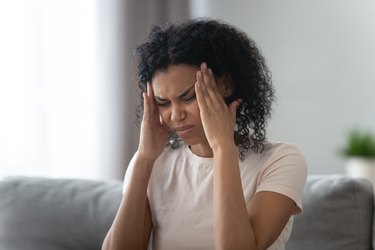
If you have head pain that feels like a throbbing vein in your temple or a pulsating vein in your head, you may have one of the many types of vascular headaches. Vascular headaches are a group of headaches that cause throbbing pain, according to the National Headache Foundation.
Throbbing or pulsating headaches are partly caused by swelling of blood vessels — either veins or arteries — in your scalp or your head, the foundation says. These headaches may be made worse by physical exertion that increases pressure inside blood vessels.
Video of the Day
Video of the Day
"Throbbing is a description of headache pain that may mean different things to different people," says Deepa Iyengar, MD, a professor of family and community medicine with McGovern Medical School at UTHealth in Houston. "Throbbing could also be described as stabbing, pounding or pulsating. Diagnosing these types of headaches depends on other factors like sex, age, when, where and triggers."
The most common type of headache is a tension headache, according to Harvard Health Publishing. Tension headaches do not throb, but cause a feeling of pressure in your head.
The Headache Behind the Throbbing
Several types of headaches can cause the throbbing of a vascular headache, including:
Migraine headache: Though migraines are less common than tension headaches, they're often more severe, according to Harvard Health Publishing. They are caused by changes in the brain's blood flow and nerve activity. Triggers include lack of sleep, hunger, certain foods and emotional stress. They're more common in young women. Classic migraine features include:
- Pulsating or throbbing pain.
- Pain on one side of the head.
- Pain that lasts for a whole day if not treated.
- Pain that keeps you from daily activities (disabling pain).
- Nausea and vomiting.
Cluster headache: This headache is less common than migraine but also very severe, Harvard Health Publishing says. It's five times more common in men, usually occurring in middle age and often triggered by smoking. These headaches are called cluster headaches because attacks come in clusters of up to eight daily headaches that last for 30 to 60 minutes. Daily clusters may last for one to three months and return about the same time every year. Other classic signs include:
- Severe stabbing pain on one side of the head.
- A red and watery eye or drooping eyelid on the same side as the pain.
- Runny or stuffy nose on the same side as the pain.
Temporal arteritis: Temporal arteritis is pain on the side of your head caused by inflammation of blood vessels near your scalp, the Cleveland Clinic says. This condition is also called giant cell arteritis. This vascular head pain almost always occurs in people older than 50. It causes throbbing pain on one or both sides of your head, and can affect blood vessels throughout your body. Other symptoms may include:
- Loss of vision, double vision or blurry vision.
- Fever, fatigue and weight loss.
- Jaw pain when chewing.
- Muscle aches in the arms, shoulders, hips and legs.
Aneurysm: As the National Headache Foundation explains, an aneurysm is caused by a weakness in a blood vessel. The weak area bulges out, which can cause the blood vessel to leak or rupture. A brain aneurysm can cause a vascular headache that is similar to a migraine or cluster headache. However, an aneurysm is dangerous because it may cause bleeding in the brain, says Mayo Clinic. Warning signs include double vision, stiff neck and sudden, unbearable pain.
Other throbbing headaches: The following three headaches all cause throbbing due to swelling blood vessels in your brain and are types the National Headache Foundation considers throbbing vascular headaches:
- Caffeine withdrawal headache.
- Hangover headache.
- Hunger headache.
Red Flags for a Throbbing Headache
"Any severe headache that lasts a long time or keeps coming back deserves a call to your doctor," Dr. Iyengar says. "For throbbing or vascular type headaches, these red flags could indicate a dangerous headache that needs prompt medical attention":
- A new and severe headache after age 50.
- Any headache that feels like a worst-ever headache.
- A headache that occurs after head trauma.
- A headache that gets worse with bending over, straining or coughing.
- A headache that causes changes in vision, tingling or numbness.
Read more: Is Your Home Giving You a Headache?
- National Headache Foundation: "Vascular Headaches"
- Harvard Health Publishing: "Headache: When to Worry, What to Do"
- Cleveland Clinic: "Temporal Arteritis"
- National Headache Foundation: "The Complete Headache Chart"
- Deepa Iyengar, MD, professor of family and community medicine, McGovern Medical School, UTHealth, Houston
- Mayo Clinic: "Brain Aneurysm"
Is this an emergency? If you are experiencing serious medical symptoms, please see the National Library of Medicine’s list of signs you need emergency medical attention or call 911.